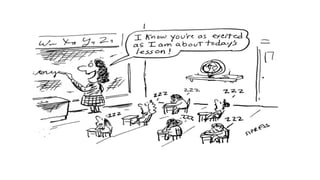Lecture 4 A.pptx
•Download as PPTX, PDF•
0 likes•3 views
Pedagogical representations
Report
Share
Report
Share

Recommended
Makabayan is the learning area that lays most stress on the development of social awareness, empathy and a firm commitment to our common goal as a nation.
It entails the use of integrated units, which enable the individual to personally process, assimilate and systematically practice wide range of values and life skills including work ethic. Principles and strategies of teaching learning makabayan

Principles and strategies of teaching learning makabayanMamWamar_SHS Teacher/College Instructor at ESTI
Recommended
Makabayan is the learning area that lays most stress on the development of social awareness, empathy and a firm commitment to our common goal as a nation.
It entails the use of integrated units, which enable the individual to personally process, assimilate and systematically practice wide range of values and life skills including work ethic. Principles and strategies of teaching learning makabayan

Principles and strategies of teaching learning makabayanMamWamar_SHS Teacher/College Instructor at ESTI
More Related Content
Similar to Lecture 4 A.pptx
Similar to Lecture 4 A.pptx (20)
Advance Organizer Cognitive Instructional Strategy

Advance Organizer Cognitive Instructional Strategy
2019 inductive versus deductive teaching methods.pdf

2019 inductive versus deductive teaching methods.pdf
Frameworks for teacher training sessions and workshops pdf

Frameworks for teacher training sessions and workshops pdf
Recently uploaded
Recently uploaded (20)
Micro-Scholarship, What it is, How can it help me.pdf

Micro-Scholarship, What it is, How can it help me.pdf
Python Notes for mca i year students osmania university.docx

Python Notes for mca i year students osmania university.docx
Presentation by Andreas Schleicher Tackling the School Absenteeism Crisis 30 ...

Presentation by Andreas Schleicher Tackling the School Absenteeism Crisis 30 ...
Measures of Dispersion and Variability: Range, QD, AD and SD

Measures of Dispersion and Variability: Range, QD, AD and SD
ICT role in 21st century education and it's challenges.

ICT role in 21st century education and it's challenges.
Z Score,T Score, Percential Rank and Box Plot Graph

Z Score,T Score, Percential Rank and Box Plot Graph
Basic Civil Engineering first year Notes- Chapter 4 Building.pptx

Basic Civil Engineering first year Notes- Chapter 4 Building.pptx
Russian Escort Service in Delhi 11k Hotel Foreigner Russian Call Girls in Delhi

Russian Escort Service in Delhi 11k Hotel Foreigner Russian Call Girls in Delhi
Lecture 4 A.pptx
- 2. Pedagogical representations in PCK Based on their PCK, teachers translate subject content knowledge into useful forms of representations of ideas in the form of “powerful analogies, illustrations, examples, explanations and demonstrations” to facilitate comprehension by students (Shulman, 1986).
- 3. Pedagogical representations in PCK Based on their PCK, teachers translate subject content knowledge into useful forms of representations of ideas in the form of powerful i. Demonstrations (Visual Models) ii. Analogies, iii. Illustrations, iv. Examples, v. Explanations vi. ‘Simulations’ to facilitate comprehension by students (Shulman, 1986).
- 4. Demonstrations (Visual models) A scientific demonstration is a scientific experiment carried out for the purposes of showing scientific principles, rather than for hypothesis testing or knowledge gathering.
- 5. Analogy An analogy is a process for identifying similarities between different concepts, the familiar concept is called the analog and the unfamiliar concept is called target (Glynn, 1991). Analogies can serve as early “mental models” that students can use to form limited but meaningful understandings of complex concepts. Knowing how to use analogies effectively is an important part of teachers’ pedagogical content knowledge (Gess-Newsome, 1999). A systematic comparison, verbally or visually, between the features of the analog and target is called a mapping.
- 6. Why is the analogy described as a “double-edged sword”? Use an example to explain. • Although they can facilitate the learning of abstract concepts, they can lead to misconceptions. • Consider the analogy of the “water pipe” and “electrical wire.”
- 7. Teaching with analog (By Glynn, 1994) 1. Introduce the target concept 2. Remind students of what they know of the analog concept 3. Identify relevant features of analog and the target 4. Map the similar features of the analog and the target 5. Indicate where the analogy between the analog and target breaks down 6. Draw conclusions
- 8. The instructional role of illustrations: • Can attract learners’ attention – a precondition to learning • Aid retention • Enhance understanding of abstract and concrete concepts • Good visuals will motivate learners and improve comprehension • Used to highlight key concepts
- 10. Examples: • Serves as vehicle for both conceptual learning and affective engagement • Contextualising scientific concepts • Helps learners understand abstract conceptual knowledge • Examples become an important part and a significant element for special reference • Teachers use certain examples to explain and give scientific understanding to the students • Examples plays a significant role in developing the conceptual
- 11. EXPLANATIONS: • Statement or set of statements that clarifies the reasons, causes, context, or principles that underpin a particular phenomenon • Central to the discipline of science as one of the goals of the discipline is to provide explanations that lead to a deeper understanding of concepts • Explanations usually has 5 parts: oNaming or specifying the concept oDescribing elements or components of the concept in an appropriate order oExplaining how the elements relate or connect to each other oProviding an example oConcluding statements
- 12. Promoting explanations through…… • Making explanation explicit • Writing scientific explanations • Predict-Observe-Explain (POE) • Concept maps • Digital representations
- 13. YOUR TURN: • Watch this video: https://www.youtube.com/watch?v=h79K6yiAM6k • Analyse the video by following the Teaching with analog six steps • Discuss the strengths of using this analogy • Discuss the limitations associated with using this analogy in the classroom • Possible misconceptions arising from using this analogy in a classroom
- 14. Next Lecture Prep: • Watch this video: https://www.commonsense.org/education/videos/introduction-to- the-tpack-model • Read this article and summarise: https://www.learntechlib.org/p/29544/
- 15. Any concerns, queries, complains? The end, Take care
